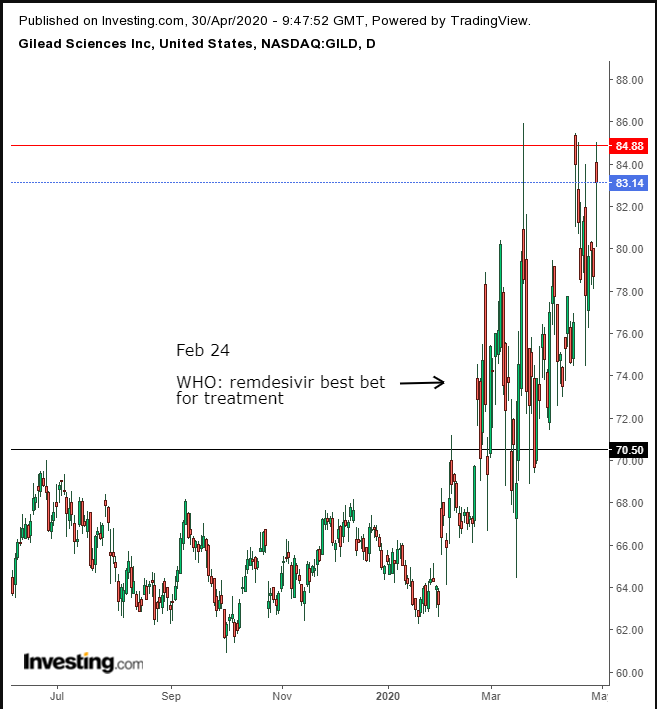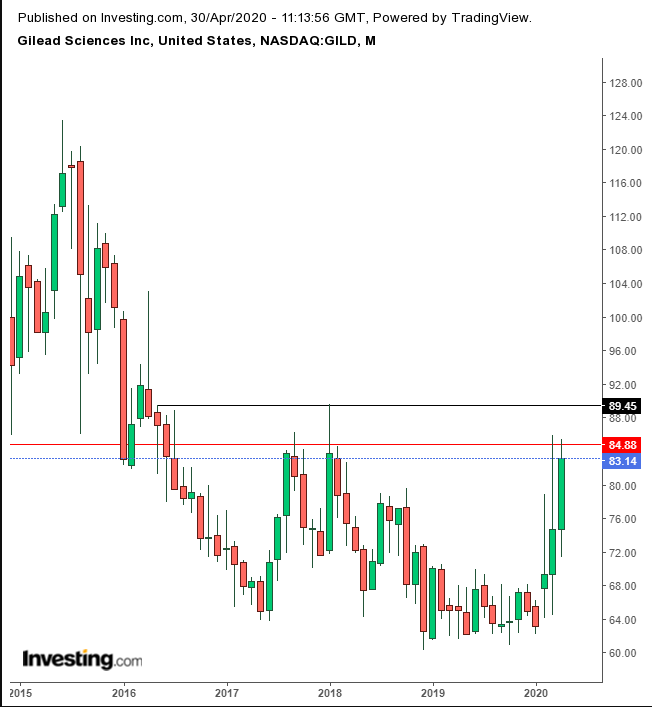Gilead Sciences (NASDAQ:GILD) is expected to report Q1 2020 earnings today, Thursday, April 30, after the close. The Forest City, CA-based biopharmaceutical company is anticipated to report $1.59 EPS, about 10% less than the $1.76 EPS posted for the same quarter last year, on $5.37B in revenue.
Gilead's CFO, Andrew Dickenson, already warned in February that the first quarter would be disappointing. But, after yesterday's disclosure in the Oval Office by Dr. Anthony Fauci, Director of the U.S.'s National Institute of Allergy and Infectious Diseases, that his agency had completed a clinical trial of the biotech's experimental remdesivir antiviral drug as a possible treatment for COVID-19, and, according to the Washington Post found it "accelerated the recovery of hospitalized patients but had only a marginal benefit in the rate of death," markets took the statement as a positive sign.
The stock surged as much as 8% higher, closing up 5.7% at $83.14. So, will investors really care about today's earnings report? Probably not. Here's proof.

The stock has been drifting above $60 since December 2018. It broke out on Feb. 24 after Bloomberg reported “a senior World Health Organization official said the company’s experimental drug may be the best bet to find a treatment for the new coronavirus spreading around the globe.”
The 20% jump since that breakout is due entirely to remdesivir. Moreover, investor expectations for Gilead's fortunes and the momentum of its stock are now riding entirely on hopes for remdesivir. And for now, at least, it seems investors are willing to hold on to hope.

In the course of little more than two months, the price returned to its highest levels since January 2018. Note, that $85 level has been a reccurring stress point since February 2014. The last monthly close above that level was in May 2016. A monthly close above that level would suggest a new era for Gilead’s shares, with the $85 high turning into a floor from a near-three-year ceiling.
Trading Strategies
Conservative traders should wait for a close above $90, a resistance level since May 2016, then wait for a return move that would find support above the new presumed support of $85.
Moderate traders may buy after a breakout with a monthly close, even below $90, but wait for a pull back to buy the dip.
Aggressive traders might go long with the monthly close above $85, depending on their trade plan.
Trade Sample
- Entry: $85
- Stop-Loss: $80
- Risk: $5
- Target: $100
- Reward: $15
- Risk:Reward Ratio: 1:3
Note: A trade sample is a device to convey the key components of a coherent trade plan. Not every trade can win. No trade is suitable for all traders. Feel free to change the entry points, stop-loss and target per your temperament and capita. But you must trade according to your preset plan, or your trade results — good or bad — will be meaningless.
